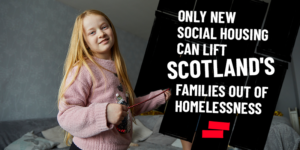Around 23% of homes in Scotland are social rented homes, but there’s often a lot of misconceptions about social housing and the people who live in it. So, here’s 7 things you might not have known about social housing:
1
“Social housing” goes by a lot of names: Council housing, council estates and housing association houses are all common terms, but they all describe forms of social housing. At its heart though, social housing is about genuinely affordable, safe, permanent homes.
2
Social homes and affordable homes aren’t the same thing: While all social homes should be affordable not all “affordable homes” are social. Confusing right? The term “affordable homes” is often used to describe a whole range of initiatives such as mid-market rent, low-cost homeownership and even shared equity. But a lot of these so-called “affordable homes” are still financially far out of reach of the people that need them. That’s why Shelter Scotland continues to call for more social homes, which are genuinely affordable and provide stability for the people that live there.
3
There used to be a lot more social housing in Scotland: In 1975 54% of homes in Scotland were council-owned. Then, in 1980 the Right to Buy was introduced. This gave council tenants the option to buy their house from the council. In the following 30 years, more than half a million council homes were sold off, while investment in new social housing was slashed. This left a huge hole in the available housing stock and waiting lists grew and grew.
4
There’s a huge shortage of social housing across the country: In each of Scotland’s four largest cities there’s an urgent need for more social housing. Based on their councils’ own figures, in the next five years Edinburgh needs at least 7,000 social homes, Glasgow needs 3,675, Aberdeen needs 853 while Dundee requires 655. Failure to deliver these homes will mean waiting lists continue to grow, people will be more exposed to the risk of homelessness and communities will suffer.
5
There are more than 7,500 children in Scotland with no permanent home: Right now, 7,510 children are trapped in temporary accommodation, often in cramped, unsuitable conditions. The effects of waiting for a place to call home are shattering. Research has shown, children who have been homeless are three to four times more likely to experience mental health problems than children who have never been homeless. Teachers say that children who are homeless or in bad housing are often late, exhausted and struggle to maintain relationships with other children. Social housing can stop children from suffering like this and end the reliance on temporary accommodation.
6
By providing secure tenancies and genuinely affordable rents, social housing gives people long-term homes and allows them to settle. Thousands of people in Scotland are currently trapped in temporary accommodation, in large part because there is a serious shortage of social housing. With rents rising in the private sector and the cost of living going up as well, increasing the supply of social housing is the only way to fight back against the housing emergency.
7
Plans are in place to deliver more social homes, but we need to make sure they’re built: Local authorities have plans in place to deliver more social homes, but we need to keep the pressure on to make sure they’re built. We know that social house building targets have been missed before, but that can’t happen again. The pandemic slowed down building projects across the country, but that just means there’s even less time to waste. The communities suffering at the sharp end of the housing emergency can’t wait any longer.
Click this link and join us in demanding the social homes that Scotland needs to end the housing emergency.



